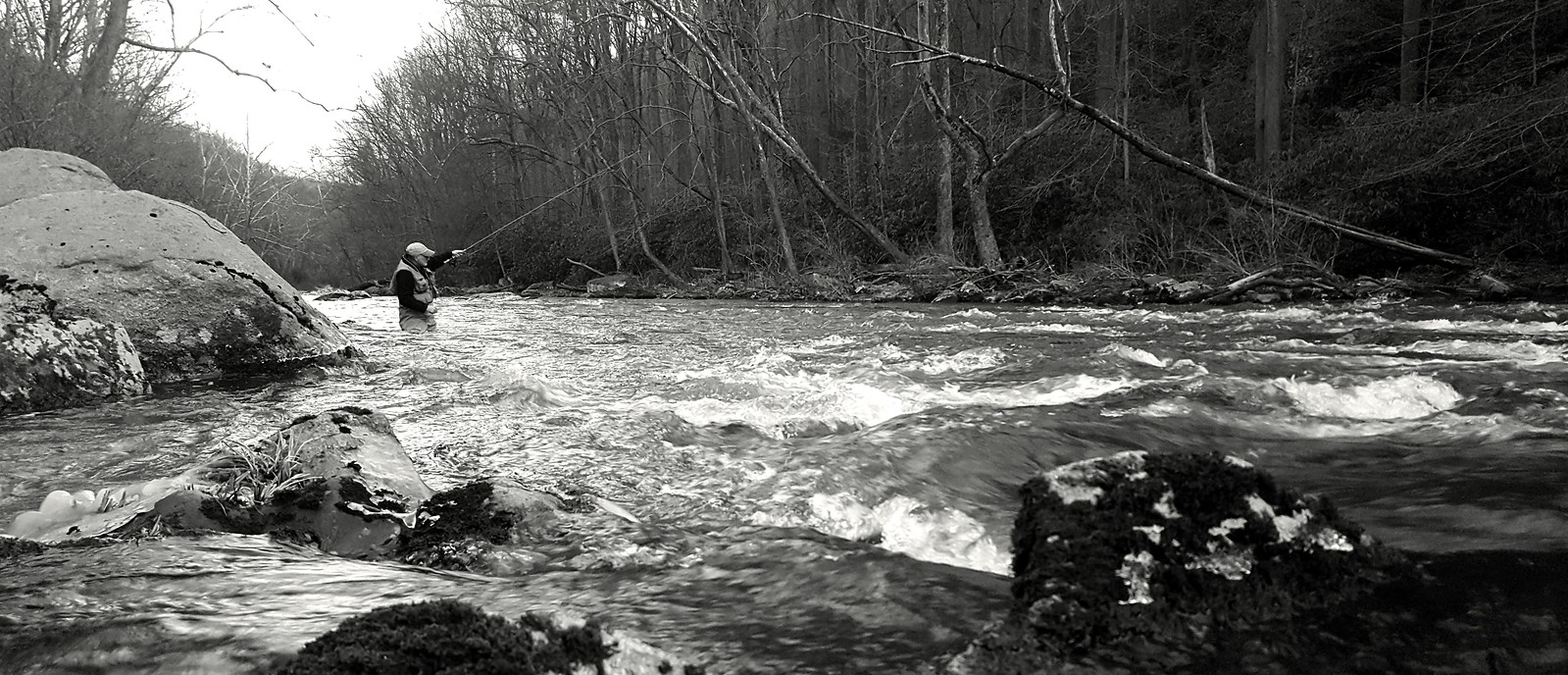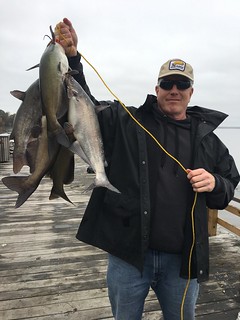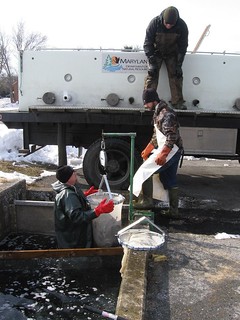Maryland Fishing Report – Early Winter
Winter is knocking and those who can dress warm have many fishing opportunities to indulge in through the season. The preseason stocking of trout is occurring, and fishing for tautog off Ocean City is good.
Many other species are available in waters across our state – check the online Maryland Guide to Fishing and Crabbing on the Maryland Department of Natural Resources website for more information.
Forecast Summary: December 2022 – January 2023:
With water temperatures in the middle 40s, most Chesapeake Bay fish are now in winter holding areas. With plenty of cool waters and oxygen from surface to bottom, look for concentrations of fish in some of the remaining warm water areas. In the main Bay, warmer bottom waters – below 50 feet – are generally located from the Bay Bridge south to near the state line, in areas with good structure and protection from strong current such as underwater points, channel edges, and bridge pilings with nearby oyster bottom and reefs. The other areas to consider are near the water discharges of your local power plants.
We will begin our weekly Bay fishing conditions forecasts again in March. However, for those hearty cold water anglers, all water conditions maps, plots and satellite pics will be continuously updated and posted. So for detailed and up-to-date fishing conditions in your area of the bay, continue to check out Click Before You Cast.
At the Conowingo Dam pool flathead catfish are providing plenty of action in the wash below the power generation turbines. Anglers are suited up in waders and casting fresh cut baits of gizzard shad, menhaden, suckers, or bluegills into the current with large surf fishing outfits. Many of these flatheads will weigh 30 pounds or more.
Blue catfish can be found in the lower Susquehanna River and as the waters become colder. The deep hole just below the Railroad Bridge will be one of the best spots to find them. They will also be found in the deeper channels in the lower sections of the region’s tidal rivers. The Chester River has some of the largest blue catfish populations in the upper Bay..
Channel catfish will be found in the deeper channels in the lower sections of the region’s tidal rivers. White perch will also be found in these same deep waters. Yellow perch will be staging in some of the deeper holes in the middle river sections. For the next couple months they too can be found in the deep hole of the Susquehanna River below the Railroad Bridge. Bottom rigs baited with small minnows and heavy weight are usually the best way to catch them.
The striped bass season closed and the fishery is now catch-and-release only. Most of the striped bass that are holding in deep waters in the upper Bay are in no mood to feed or to go after jigs. If the fish are located holding in a deep hole, don’t be surprised that you snag more often than a fish will take your jig – the water is just too cold.
Fishing for striped bass is now strictly catch and release and if you give it a whirl on a calm and sunny day, the fish are holding in the deepest parts of the shipping channel and to a lesser degree the False Channel. They are also tucked in like cordwood at the bottom at the Bay Bridge rock piles but unlikely to bite – best to just leave them alone. The warm water discharge at the Calvert Cliffs Power Plant will always get the attention of anglers during the cold winter months. Anglers may even find a speckled trout nosed into the warm water there if they’re lucky.
White perch can be found deep in several areas in the middle Bay, usually around the 40-foot mark. Large white perch can be found at the rock piles at the Bay Bridge, holding deep in the swift current. It will take a heavy jig or dropper rig to get to them. The 40-foot channel edge out in front of Matapeake is another traditional area for white perch to be holding, before that edge drops off into 100 feet of water. You can find them on your depth finder be aware you may also detect schools of gizzard shad hunkered down in the same areas.
The calmer and more protected waters of the tidal rivers can offer plenty of good fishing for channel and blue catfish. The channel catfish can be found in the upper sections of the tidal rivers holding deep. The blue catfish are mostly in the Choptank River and can be found deep in the channel from the Dover Bridge area and upriver. Fresh cut baits are tough to come by this time of the year so do the best you can; if you’re anchored up, creating a chum slick helps.
If striped bass are your target this month, the lower Potomac River is open until December 31. The fish must measure 20 inches or more. All other Maryland and Virginia waters of the Chesapeake are closed and only allow catch-and-release fishing for striped bass.
If you do focus on striped bass, the best action is occurring from the mouth of the Wicomico River south to the mouth of the Potomac along the channel edges. Bird activity can be sparse so keep a watchful eye on a depth finder along the deeper channel edges. The section of the Potomac from the St. Marys River to Point Lookout is the best place to find diving gulls and breaking striped bass..
Jigging has been a very popular way to fish along the channel edges and anglers are using 1- to 1.5-ounce soft plastic jigs from 6-8 inches with good success. White and chartreuse colors are popular, braided line and a fast taper fishing rod are very helpful tools of the trade. Trolling is another option, and a warm cabin can offer an inviting way to fish. It will take stout trolling rods to handle the heavy inline weights needed to get bucktails, sassy shads, or umbrella rigs down to where the fish are holding.
The Potomac, Patuxent, and Nanticoke rivers all offer excellent fishing opportunities for blue catfish. The area around Fort Washington tends to be a hotspot during the winter months. The same can be said for the area below Jug Bay on the Patuxent and the Sharptown area on the Nanticoke. The blue catfish tend to be holding deep in the channels and oily cut bait is a popular choice.
With some careful depth-finder tactics, white perch can be found holding in the lower Patuxent River near the bridge piers of the Route 4 Bridge in the deepest waters. At the mouth of the Patuxent in about 40 feet of water they can often be found holding close to the bottom. The deep water just below R16 or Sharkfin Shoal at the mouth of the Nanticoke River is another good place to look for white perch schooled up for the winter.
The preseason trout stocking program started in early December with several large trout stockings. Savage Reservoir, Blairs Valley Lake, Greenbrier Lake, Deep Creek Lake, and Piney Run Reservoir received anywhere from 1,000 to 4,000 trout each for put-and take-fishing. The delayed harvest areas of Town Creek and the Youghiogheny also received substantial stockings, and the Daniels area on the Patapsco River was stocked with 2,000 rainbow and brown trout. Up-to-date information can be viewed at the trout stocking website.
The fall electrofishing surveys for the upper Potomac River have been completed. Low flow conditions through the fall made boat access difficult in multiple sections of the river. Overall, smallmouth bass densities looked good, with an average catch rate of 35 fish per hour of quality size fish of 11 inches and more. All smallmouth bass appeared healthy and in good condition. Catch rates for smallmouth bass in the 8-inch to 11-inch range were also good, showing an improvement in recruitment. Invasive flathead catfish continue to be collected and tagged during the surveys; the largest measured 36 inches.
The winter months are traditionally a good time to fish for smallmouth bass and walleye on the upper Potomac River. The fish will be found deep along channel edges, current breaks, pools, and deep-water ledges. A variety of jigs, tubes, and small crankbaits worked close to the bottom tend to be the best tactic. The river has been running low and clear, but water levels may rise with predicted weather events. Approved life jackets or PFDs must always be worn while fishing or boating on the upper Potomac from November 15 to May 15.
It appears the walleye hatch from this past spring are providing catchable fish in the 11-inch to 13-inch range. These young walleye tend to school during winter so if you find one, more typically follow. With the current conditions, a subtle approach is necessary. Slow retrieves with either bottom jigs or allowing the current to naturally swing a jerkbait work best. Once we see some increased flows, the fish will be pushed into the shoreline eddies, especially given the cold water temperatures.
Deep Creek Lake is beginning to see various coves icing up and anglers will start to get itchy for some ice fishing. Patience is in order – never venture out on the ice without a pair of ice spikes.
Largemouth bass are generally holding deep along drop-offs, channels and deep structure. They will seek out deep cover wherever they can find it and usually stick close to it. There will be some movement by mid-day on sunny days; they will move into slightly shallower waters that are being warmed by the afternoon sun. If you find structure in the form of sunken wood, bridge piers, or rocks, cast to the sunny side of the structure.
Largemouth bass are going to be very lethargic so it will take something small that is right in front of their nose to entice them. Small and slow tends to be the mantra for winter largemouth bass fishing. Small finesse jigs, shaky head rigs, Ned rigs, and drop shot rigged soft plastics are all good choices for working deep structure. Small flat-sided crankbaits and Colorado blade spinnerbaits worked in the transition zones between deep and shallower waters during the afternoon hours can also be a good choice. They should be retrieved very slowly along the bottom.
Chain pickerel will be entertaining anglers in the upper sections of the bay’s tidal rivers and creeks, and in reservoirs and ponds across the Maryland landscape. Being ambush predators they will seek out sunken wood along shorelines now that grass beds are gone. Casting paddletails with a single hook is one of the better ways to fish for them and helps greatly with removing the hook and releasing the fish in good condition. Treble hooks often spell tragedy for chain pickerel since they tend to engulf lures and wind up with the hooks in their gills.
Crappie do not mind cold water and can be found this time of the year holding deep near structure. Marina docks are a favorite habitat for them, fallen treetops, bridge piers, and sunken brush are all good places to find them. At some of the DNR controlled impoundments such as Unicorn Lake, biologists have sunk old Christmas trees to provide structure for crappie to hold to. Small minnows or marabou jigs under a slip bobber are good ways to fish for them.
Surf anglers are braving the cold at the Assateague Beaches and soaking large cut baits, hoping to intercept striped bass that measure over 28 inches. Along the coast, striped bass measuring less than 28 inches or greater than 35 inches must be returned to the water unharmed. Striped bass are being caught at the inlet and Route 50 Bridge area by anglers casting soft plastic jigs or by drifting cut bait. Most of the striped bass fail to meet the 28-inch minimum but the catch-and-release action is plenty of fun.
Tautog are providing fishing opportunities at the inlet jetties, the Route 50 Bridge piers, and nearby bulkheads. Sand fleas are the preferred bait. A fair percentage of the tautog being caught fail to meet the 16-inch minimum but the fishing is fun. The daily creel limit for tautog is four per day.
Now that the black sea bass season is closed, tautog are also the focus at the nearshore and offshore wreck and reef sites. Most anglers are doing well and some double-digit size tautog are being caught. Pieces of green crab and white-legger crabs along with sand fleas are the baits of choice.
“Soon after I embraced the sport of angling, I became convinced that I should never be able to enjoy it if I had to rely on the cooperation of the fish.” Sparse Grey Hackle
Maryland Fishing Report is written and compiled by Keith Lockwood, fisheries biologist with the Maryland Department of Natural Resources.
Click Before You Cast is written by Tidewater Ecosystem Assessment Director Tom Parham.
This report is now available on your Amazon Echo device — just ask Alexa to “open Maryland Fishing Report.”





